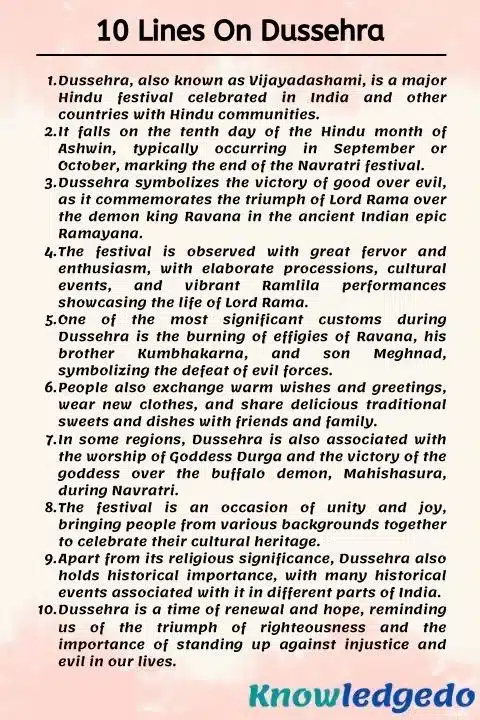Today, we are sharing 10 lines on Dussehra in English. This article can help students who are looking for information about 10 lines on Dussehra. These lines are straightforward and easy to remember. The level of difficulty is moderate, making it accessible for any student to write on this topic.
This article is generally useful for class 1,class 2,class 3,class 4,class 5,class 6,class 7,class 8,class 9,class 10,class 11,class 12
10 lines on Dussehra
1) Dussehra, also known as Vijayadashami, is a major Hindu festival celebrated in India and other countries with Hindu communities.
2) It falls on the tenth day of the Hindu month of Ashwin, typically occurring in September or October, marking the end of the Navratri festival.
3) Dussehra symbolizes the victory of good over evil, as it commemorates the triumph of Lord Rama over the demon king Ravana in the ancient Indian epic Ramayana.
4) The festival is observed with great fervour and enthusiasm, with elaborate processions, cultural events, and vibrant Ramlila performances showcasing the life of Lord Rama.
5) One of the most significant customs during Dussehra is the burning of effigies of Ravana, his brother Kumbhakarna, and his son Meghnad, symbolizing the defeat of evil forces.
6) People also exchange warm wishes and greetings, wear new clothes, and share delicious traditional sweets and dishes with friends and family.
7) In some regions, Dussehra is also associated with the worship of Goddess Durga and the victory of the goddess over the buffalo demon, Mahishasura, during Navratri.
8) The festival is an occasion of unity and joy, bringing people from various backgrounds together to celebrate their cultural heritage.
9) Apart from its religious significance, Dussehra also holds historical importance, with many historical events associated with it in different parts of India.
10) Dussehra is a time of renewal and hope, reminding us of the triumph of righteousness and the importance of standing up against injustice and evil in our lives.

5 lines on Dussehra
1) Dussehra, also called Vijayadashami, is a Hindu festival celebrated to commemorate the victory of good over evil.
2) It falls on the tenth day of the Navratri festival and holds significant religious and cultural importance.
3) The festival is marked by the burning of effigies of the demon king Ravana, his brother Kumbhakarna, and his son Meghnad, symbolizing the triumph of righteousness.
4) People exchange greetings and sweets, and colourful processions are held across various regions in India.
5) Dussehra fosters a sense of unity and joy as people come together to celebrate this auspicious occasion.
>10 lines on Durga Puja in English
>10 lines on navratri in English
FAQ
Answer: Dussehra holds immense religious significance as it symbolizes the victory of good over evil. It commemorates the triumph of Lord Rama over the demon king Ravana in the ancient Indian epic Ramayana. The festival signifies the victory of righteousness and the importance of upholding moral values.
Answer: Dussehra is celebrated with varying customs and traditions across different regions of India. The common theme, however, is the burning of effigies of Ravana, Kumbhakarna, and Meghnad, representing the defeat of evil forces. Additionally, cultural events, Ramlila performances, processions, and worship of Goddess Durga during Navratri are part of the celebrations in various parts of the country.
Answer: Dussehra falls on the tenth day of the Hindu month of Ashwin, which usually corresponds to September or October in the Gregorian calendar. The date varies each year as it follows the lunar calendar. The festival is celebrated after the nine-day Navratri festival, culminating on the tenth day, which is Dussehra or Vijayadashami.
